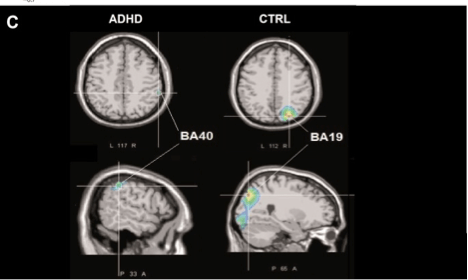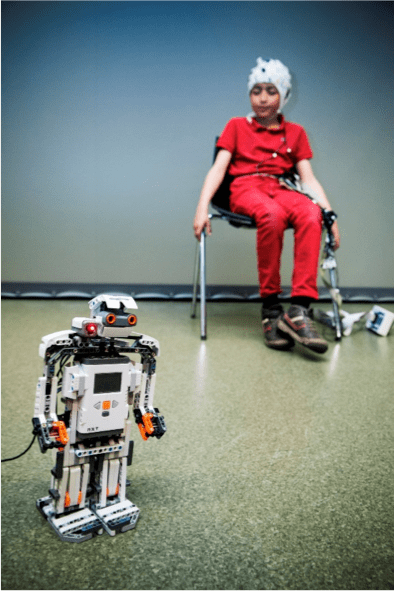In 2013, a new BioWin project, NeuroAtt, was launched to arrive at a reliable diagnosis for ADHD (Attention Deficit Hyperactivity Disorder) and to find the least invasive treatment for children. As NeuroAtt nears completion, we asked the project’s team leader, Human Waves CEO Anne-Marie Clarinval, for her insights.
Why are you interested in attention disorders?
Anne-Marie Clarinval: “Because of the strong social interest, given that attention disorders affect between 5% and 7% of the school population. Also, the diagnosis, which is principally a clinical one, remains problematic. The child, the parents and sometimes the teachers complete a questionnaire; the child has to undergo a lot of tests conducted by a psychologist before being referred to a child psychiatrist — this all takes a lot of time and money. With NeuroAtt, we wanted to develop a diagnostic tool to complement the existing clinical approaches and thereby speed up the diagnostic process and reduce the cost.”
How does the new method diagnose ADHD?
Clarinval: “We place the child before visual stimuli on a computer and register the cerebral activity. Depending on these stimuli, the child is asked to carry out an action; for example, press the computer space bar or not. During the analysis, we can very clearly monitor the differences in the cerebral signals between a person suffering from the disorder and one who does not. We are also able to identify the origin of the cerebral signals in the brain using high-density electroencephalograms and mathematical and statistical models (see illustration).
Attention disorders affect between 5% and 7% of the school population.

Difference in locating the origin during the “Cue” event among controlled and ADHD children.
“In short, the NeuroAtt project has enabled us to render a computer algorithm that will assist the diagnosis of the disorder. In this last year that the project is running, the diagnosis assistance tool will be finalized and normalized, which is essential when it comes to marketing the program.”
Are better treatments available?
When the child produces these alpha rhythms, he or she is rewarded by a little robot that starts walking.
Clarinval: “At present, in most cases advice is provided and psychosocial treatment is put into place. Children are also prescribed Ritalin, an amphetamine derivative that can have a series of side effects. But with NeuroAtt, we aim to find a natural treatment that we call ‘positive neurofeedback,’ and that is based on the measurement of cerebral rhythms coupled with a play element. We are working on alpha rhythms, which are produced when the child feels relaxed. We ask the child to think of something nice. When the child produces these alpha rhythms, he or she is rewarded by a little robot that starts walking. That is the positive and fun feedback. Based on the same principle, the child can also generate other rhythms linked to attention. This treatment is still at the research and development stage, but we are very pleased with the initial results.”
You founded Human Waves when the project was launched. Is health the only field in which the company is active?
Clarinval: “No, it isn’t. Our company manages a technological platform that enables us to record, measure and analyze all kinds of biological signals. The principle behind our approach is to develop our services and our products according to the needs of our customers. This enables our platform to be used in the health sector, as well as for sports: both high-level sport and sport for disabled persons. We measure ocular activity, the positioning of the eyes and muscular activity, as well as performing strength analysis, etc. The biomechanics of movement is also one of our strengths. We have a 3D system based on the kinematics and dynamics of movement that uses a special motion-capture technique in real and virtual situations, with the aim of helping people find winning neuromotor strategies.”
This is why you developed the 3D Visual Trainer?
Clarinval: “Yes, the 3D Visual Trainer is a tool for training the visual perception for a variety of applications. For example, it is used today by the Charleroi Zebras and other athletes, as well as by security agents, driving instructors, drivers of large vehicles — all kinds of occupations that require rapid analysis and decision-making. The advantage of this product is that it not only trains the visual field, it is also based on the PAMDA (Perception, Attention, Memorization, Decision, Action) paradigm. It develops the capacities of the individual to better perceive the situation he finds himself in, to pay attention to several elements at the same time, to memorize what is happening, to take a quick decision and to act on it equally quickly. In the case of a soccer player, it enables the player to quickly change strategy to avoid a defender. It can also be used to determine the risk of injury in sports in which contact is frequent (football, basketball, rugby, etc.).”
As if all this were not exciting enough, you are also taking part in space research?
Clarinval: “We have just received the ESA (European Space Agency) trademark, making us very proud. Professor Guy Chéron, co-founder and team member of Human Waves, was asked to analyze the encephalograms (EEGs) of astronauts at the international space station. This initiated many of the current developments. We see that the astronaut’s brain rhythms are totally different. At a space station, you are in a free-floating environment, and when carrying out a task on a computer, the brain realizes that the body is in constant movement. Situating your body on earth is basic. Not so in space. Weightlessness upsets perception and makes constant demands on the brain’s energy. This means that the brain manages any cognitive task in these conditions differently.”
NeuroAtt project partners
Academics: Prof. Guy Chéron of the Laboratory of Neurophysiology and Movement Biomechanics; Bernard Dan, neuropediatrician at the Queen Fabiola Children’s Hospital; Prof. Paul Verbanck, head of the Department of Psychiatry and Medical Psychology at the Brugmann University Hospital .
Industrialists: Anne-Marie Clarinval of Human Waves; Nomics (development of the electronic card in Liège); Sirris (development, testing and effective implementation of technological innovations).
(Drafted by Amélie Moyaerts, BioWin)


